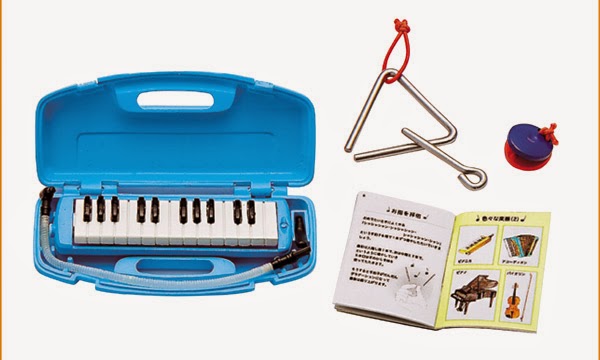1. Schoolbag
You can see two exercise books and a clarinet. And there are some small pieces of paper (I don't know what those are).
The blue book with the print of dog is used for teacher-parent contacts. It was like we record a list of homework in it when our teachers assigned daily and add a checkmark once we finish a line on the list. Each night parents took a look at the list and made sure we finished all the tasks and signed their name and left comment for the class teacher. The next day teacher will go through all the parents'signatures of the whole class and leave feedback if needed. Next to it is an exercise book for Japanese. Yes, just like American students have English class, we all have a class named our mother language. And I don't know if it's still like that, but when I was little, we were asked by school to learn a small music instrument. We could select between clarinet and harmonica. :)
It generally means the writing brush, ink stick, ink stone and paper. In ancient east countries including China and Japan, calligraphy was a necessary capability for people who were considered as "educated" or "scholar". Of course our generation is not required to learn it but see it as a hobby, art and skill too.
3. Chemistry Lab
I have no idea what's this experiment about. Actually I didn't start to learn chemistry until junior school. But in high school we could choose either chemistry or physics as our main major. And I chose physics. After that I gave all my chemistry sense back to teacher and remembered nothing about it...
4. Music
I think it's like a toy instrument set that kids always have and play the little band with the playmates.
The little instruction book introduces different small instruments. Each page is different.
I heard in Japan kids are provided with milk at lunch. When I was in elementary school milk was given after two morning classes. And after another two morning classes we would have lunch. A snack would be provided in the afternoon.
Awww I love the pink rabbit lunchbox set. I will definitely buy one for my kid in the future since I am too old for that. :P
Pocky pocky pocky! Very popular snack in Japan and China.
It seems like another Asian thing in this box --abacus. But I don't have experience with it. Guess I was born too late when advanced technology appeared. But I know in some school abacus class is provided as a hobby. It's an old thing just like calligraphy. I like the cute pencil boxes and other small things in this set. I forgot including the snack when taking the photos.
Skipping-rope, puzzle, snack, little cups, sketch book and color pens and a toy called "Tomy Wonderful Ring".
Tomy Wonderful Ring Google Picture:
9. My Treasures
A yellow panda cup, clock, electrical pencil sharpener, comic book and bookend, piggy bank and wishing bottles.Unfortunately, unless you learned it by purpose, my generation in China didn't have any school class teaching sewing. My mom doesn't know it either so no one ever taught me how. But in Japan sewing class is very basic starting at a young age. What an important skill and I regret never to learn it. I could save so much on dolls' outfit if I knew how to sew.
I hope you enjoy this set and the photos! :)
I have many fond memories of elementary school life. I was always a good student, had lots of friends. My friends and I lived in the same neighborhood and went to school together. My favorite class was English and the teacher who taught it was my favorite at the time too. I was on TV once attending a contest. And swimming with friends in the summer break was the best time. But sadly all things were shadowed by an abusive female class teacher. I don't want to talk about her here to ruin my post though. But my elementary experience was so much painful because of her that even today I forgave her but never forgot...
Well, I think I may start another post to talk about it in the future...























































